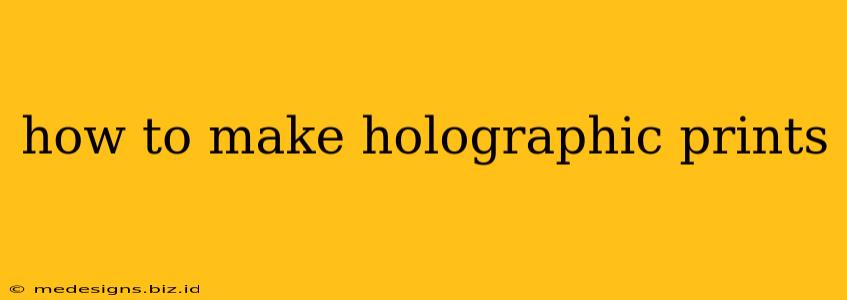Want to create stunning, eye-catching holographic prints? This comprehensive guide will walk you through the process, from understanding the basics of holography to mastering the techniques for creating your own mesmerizing images. Whether you're a seasoned artist or a curious beginner, you'll find valuable insights here.
Understanding Holographic Prints
Before diving into the creation process, let's establish a clear understanding of what holographic prints are. Holographic prints aren't simply images with a shiny, iridescent effect. They're images that utilize a special photographic technique to capture and reproduce a three-dimensional image. This effect is achieved by recording the interference patterns of light waves scattered from an object. The resulting image appears to change as the viewer's perspective shifts, giving it a truly unique depth and dynamism.
Types of Holographic Prints
There are several different types of holographic prints, each with its own unique characteristics and production methods:
- Transmission Holograms: These holograms require a light source to be shone through them to reveal the 3D image. They're often more complex to produce.
- Reflection Holograms: These holograms reflect light to reveal the 3D image. They're more common in everyday applications, like security labels and credit cards.
- Rainbow Holograms: A type of reflection hologram designed to be viewed under white light, offering a wider viewing angle and brighter image.
Methods for Creating Holographic Prints
Creating holographic prints isn't a simple task. It requires specialized equipment and a deep understanding of optical physics. However, there are several methods, each with varying levels of complexity and accessibility:
1. Using Holographic Film and a Laser
This is the most traditional and technically demanding method. It involves using a high-powered laser to illuminate an object and record the interference pattern onto a special holographic film. This method requires a darkroom and precise control over the laser and film. High precision and a controlled environment are absolutely crucial for success.
2. Digital Holography
This more modern approach utilizes computer software and digital image processing techniques to simulate and create holographic effects. While it doesn't produce "true" holograms in the same way as the laser method, it allows for greater flexibility and easier experimentation. Software like MATLAB or specialized holographic software packages are needed.
3. Utilizing Holographic Printing Services
For those without access to specialized equipment or expertise, utilizing a holographic printing service is a viable option. Many companies offer high-quality holographic printing services, enabling you to upload your designs and receive professionally produced holographic prints. This is often the most accessible and cost-effective option for beginners and small-scale projects.
4. DIY Embossed Holograms
While not producing a true 3D hologram, you can create an impression of a holographic effect using techniques involving foil and embossing tools. This is a more accessible method for creating a shimmering, iridescent effect on prints. This method is ideal for creating simpler, more artistic effects.
Essential Equipment and Materials
The necessary equipment and materials depend heavily on the method chosen. The laser-based method requires significant investment in lasers, optical tables, and darkroom facilities. Digital holography relies on powerful computers and specialized software. Embossed hologram creation needs foil and embossing tools. If using a printing service, you will primarily need your artwork in a suitable digital format.
Tips for Success
- Research and Planning: Thoroughly understand the chosen method before starting.
- Precision and Patience: Holography is a precise art, requiring patience and attention to detail.
- Experimentation: Don't be afraid to experiment with different techniques and materials.
- High-Quality Materials: Use high-quality materials for the best results.
- Professional Guidance: If you're new to holography, consider seeking guidance from experienced practitioners.
Creating holographic prints is a challenging but rewarding endeavor. With dedication and the right tools, you can achieve stunning, visually captivating results. Remember to always prioritize safety, particularly when working with lasers.
